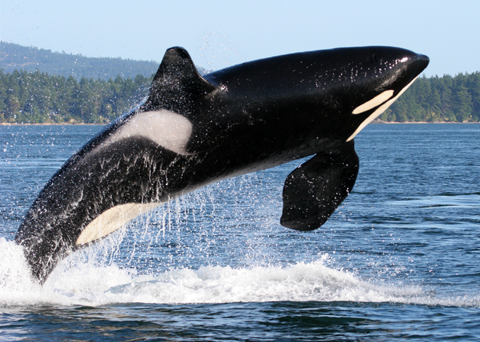
SCIENTIFIC NAME
Orcinus orca
DESCRIPTION
The orca (Orcinus orca), often called the killer whale, is actually the largest member of the dolphin family. Orcas are highly social animals that live in stable, family-related groups called pods. Their distinctive black-and-white colouring and large dorsal fin make them easy to spot and identify. As a result of increased water pollution, especially from toxic chemicals, they are listed as threatened under the Species at Risk Act. The average weight of an Ocra whale is 4 to 5 tonnes and measures between 7 to 9 metres. The lifespan for a male in the wild is 17 years and for females it's 29 years.
RANGE
Found in colder regions of all of Canada’s oceans, as well as occasionally in Hudson Bay and in the Gulf of St. Lawrence. In British Columbia, they have been seen throughout almost all marine areas, including many inlets and narrow channels.
HABITAT
DIET
Throughout their worldwide range, killer whales eat a wide variety of prey, including squid, fish, sea turtles, seabirds, sea and river otters, sea lions, penguins, dolphins and other large cetaceans, such as blue whales. Northern and southern resident killer whales, however, eat mainly fish. The preferred prey of the offshore population of killer whales is not known, but it is likely fish as well. Transient killer whales eat mainly other marine mammals. However, because they tend to spend time in water less than five metres deep, often foraging in intertidal areas at high tide, transient whales have been known occasionally to eat animals such as deer, moose and pigs.
BEHAVIOUR
undefinedPRIMARY ECOSYSTEM ROLES
Did You Know?
- Orcas communicate through a complex variety of whistles, squeaks and whines that varies from pod to pod. Each group has a unique set of sounds.
- Like other whales and dolphins, orcas use a series of clicking sounds that bounce off fish and other objects in the water. Called echolocation, this natural sonar is useful when searching for food or navigating in murky water.
- With no predators in nature, orcas can live to between 50 and 80 years of age.
- Increased shipping traffic is believed to interfere with the whales’ echolocation method of hunting, confusing them and making it hard to find prey.
- Mass strandings, in which large numbers of whales beach themselves and are unable to return to sea, are among the natural factors threatening orcas.
- 0
- 1
